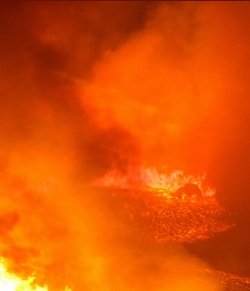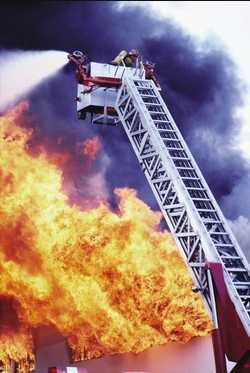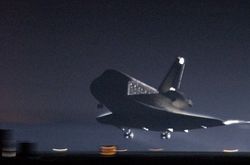During a January flight of Space Shuttle Columbia,
astronauts will test a new commercial fire-fighting system that
puts out blazes with a fine water mist -- instead of using
potentially harmful chemicals or large quantities of water that
damage property.
 "The fire-fighting industry is in search of a new
tool that doesn't use dangerous chemicals or douse fires with huge
quantities of water that cause extensive property damage," said
Mark Nall, director of the Space Product Development Program at
NASA's Marshall Space Flight Center in Huntsville (AL). "By flying
this commercial experiment on the STS-107 Columbia mission, NASA is
helping industry design a cost-effective, environmentally friendly
system for putting out fires."
"The fire-fighting industry is in search of a new
tool that doesn't use dangerous chemicals or douse fires with huge
quantities of water that cause extensive property damage," said
Mark Nall, director of the Space Product Development Program at
NASA's Marshall Space Flight Center in Huntsville (AL). "By flying
this commercial experiment on the STS-107 Columbia mission, NASA is
helping industry design a cost-effective, environmentally friendly
system for putting out fires."
 Until
recently, halons, bromine-based compounds, were used to attack
fires chemically -- especially in places like computer rooms,
aircraft, and document storage rooms where water sprinklers were
inappropriate. They were cheap and effective, and preserved, to a
great extent, materials that could have been damaged by other
methods of fire attenuation. In 1998, the production of these
chemicals was banned worldwide because they were thought to damage
Earth's protective ozone layer, though the extent to which that
damage is caused by manmade sources, or is preventable, has never
been established.
Until
recently, halons, bromine-based compounds, were used to attack
fires chemically -- especially in places like computer rooms,
aircraft, and document storage rooms where water sprinklers were
inappropriate. They were cheap and effective, and preserved, to a
great extent, materials that could have been damaged by other
methods of fire attenuation. In 1998, the production of these
chemicals was banned worldwide because they were thought to damage
Earth's protective ozone layer, though the extent to which that
damage is caused by manmade sources, or is preventable, has never
been established.
"We are working to find an acceptable replacement for halons,
and water mist appears to be the best choice," said Dr. Thomas
McKinnon, lead scientist for the research at The Center for
Commercial Applications of Combustion in Space (CCACS) at the
Colorado School of Mines in Golden. This NASA Commercial Space
Center specializes in helping industry conduct combustion research
in space through NASA's Space Product Development Program at the
Marshall Center.
"The Shuttle tests use a humidifier-like device to produce water
drops about 20 microns in size," said Dr. Angel Abbud-Madrid, the
project scientist at the NASA Commercial Space Center. "That's
about one-tenth the diameter of a human hair, as opposed to drops
produced by conventional sprinklers that are about one millimeter,
or 50 times the size of our droplets."
 The water
mist research team is working with MicroCool Inc., a division of
Nortec Industries Inc., in Palm Springs (CA), and Fogco Systems
Inc. in Gilbert (AZ). These companies manufacture water mist
systems for putting out fires and for other purposes, such as
outdoor cooling and industrial humidification.
The water
mist research team is working with MicroCool Inc., a division of
Nortec Industries Inc., in Palm Springs (CA), and Fogco Systems
Inc. in Gilbert (AZ). These companies manufacture water mist
systems for putting out fires and for other purposes, such as
outdoor cooling and industrial humidification.
"Firefighters in Denver and at the Arvada Fire Training and
Research Center have tested our ultra-fine mist nozzles," said Mike
Lemche, general manager of MicroCool. "The cooling effect of this
mist removes one of the key components of fire - heat."
Gary Wintering, president of Fogco, said his company will use
information from the STS-107 experiment to fine-tune their designs
of fire-fighting systems. Water mist systems create a fog instead
of sending out blasts of water. Since the fog removes heat and
replaces oxygen as the water evaporates, it prevents the fire from
expanding and starting new fires.
This is particularly important when fire starts in a closed
compartment on a ship, aircraft, or even on the Space Shuttle. The
U.S. Navy is already working with the airline industry and The
Center for Commercial Applications of Combustion in Space on water
mists studies.
"With halon replacements expected to be an important part of the
$2-billion-a-year fire suppression industry, it is easy to
understand why companies are flying this experiment," said Dr.
Frank Schowengerdt, director of The Center for Commercial
Applications of Combustion in Space. "These companies are testing
the system in space because it's easier to observe the interaction
between a flame and water when Earth's gravity does not cause air
currents around the flame and does not cause water droplets to
settle."
 Prior combustion experiments have shown that space
is the ideal place to study the physics of fire. On Earth, gravity
causes lighter, hotter air to rise -- creating air currents that
make it difficult to study combustion processes. In microgravity --
the low-gravity inside the Shuttle orbiting Earth - air currents
are reduced or eliminated, making it easier for scientists to
observe exactly how water interacts with a flame to put it out. Of
course, there is no ozone layer to worry about in Space, but there
is great publicity to be had, from such a high-profile test, in
addition to the scientific challenges such a test will
highlight.
Prior combustion experiments have shown that space
is the ideal place to study the physics of fire. On Earth, gravity
causes lighter, hotter air to rise -- creating air currents that
make it difficult to study combustion processes. In microgravity --
the low-gravity inside the Shuttle orbiting Earth - air currents
are reduced or eliminated, making it easier for scientists to
observe exactly how water interacts with a flame to put it out. Of
course, there is no ozone layer to worry about in Space, but there
is great publicity to be had, from such a high-profile test, in
addition to the scientific challenges such a test will
highlight.
"The Shuttle experiment will help us determine the optimum water
concentration and water droplet size needed to suppress fires,"
said Abbud-Madrid. "We have learned from short tests on NASA's
KC-135 reduced-gravity aircraft and inside drop towers that water
mists take one-tenth the water of traditional sprinklers to
extinguish a flame."
 More extensive measurements in periods of
microgravity longer than a few minutes will be possible during the
Space Shuttle Columbia's16-day mission. A mixture of propane and
air will ignite inside a clear tube to produce a thin flame --
known as a laminar flame. On the opposite end of the tube, a water
mist will be released. Digital images will record how different
size water droplets and water concentrations affect the flame.
More extensive measurements in periods of
microgravity longer than a few minutes will be possible during the
Space Shuttle Columbia's16-day mission. A mixture of propane and
air will ignite inside a clear tube to produce a thin flame --
known as a laminar flame. On the opposite end of the tube, a water
mist will be released. Digital images will record how different
size water droplets and water concentrations affect the flame.
The experiment will take place inside the safety of the
Combustion Module -- a NASA facility flown on a previous Shuttle
flight. It was developed by NASA's Glenn Research Center in
Cleveland (OH), and is the forerunner of a similar facility under
development for the International Space Station. Future water mist
investigations on the Space Station will be larger and longer,
enabling companies to test different water injection systems,
droplet sizes and fire scenarios.
 ANN's Daily Aero-Linx (04.15.24)
ANN's Daily Aero-Linx (04.15.24) Classic Aero-TV: 'No Other Options' -- The Israeli Air Force's Danny Shapira
Classic Aero-TV: 'No Other Options' -- The Israeli Air Force's Danny Shapira Aero-News: Quote of the Day (04.15.24)
Aero-News: Quote of the Day (04.15.24) Airborne 04.16.24: RV Update, Affordable Flying Expo, Diamond Lil
Airborne 04.16.24: RV Update, Affordable Flying Expo, Diamond Lil ANN's Daily Aero-Term (04.16.24): Chart Supplement US
ANN's Daily Aero-Term (04.16.24): Chart Supplement US







